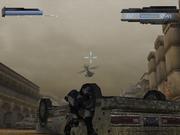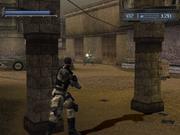At first glance, Namco's kill.switch looks like a pretty standard third-person military-themed shooter. It has a look to it that recalls both Konami's Metal Gear Solid and Ubisoft's Splinter Cell, though it focuses more on shooting enemy soldiers in the face than on deep storylines and complicated stealthy maneuvers. However, this otherwise ordinary-to-a-fault action game is given a shot in the arm by its relatively cool gameplay techniques, which--at least--make the game's short ride interesting.

The premise in kill.switch is a mysterious one. You really aren't given much background about who you are or what you're doing, but if you listen closely to the pre-mission dialogue it quickly becomes apparent that you aren't playing the role of the soldier on the screen. Rather, you're actually taking on the role of a man controlling this supersoldier via some sort of neural link. It also quickly becomes apparent that you're the bad guy of this story, committing dastardly deeds as you try to pit the world's superpowers against one another using this American-looking soldier to ensure the blame is cast elsewhere. While the game has a terrific premise and does have a twist to its plot, the storyline itself is practically nonexistent, which makes the game feel pretty disjointed and, above all, makes your actions feel meaningless, even though it's set against the backdrop of a possible world war. You get a small bit of audio at the front of each mission that's supposed to set things up a bit, but the missions and areas don't feel very related. You just run into a level and kill a bunch of people while trying to accomplish straightforward objectives.
The mission design doesn't really help matters much. By and large, your objective in each mission is to simply get to the end. At the end, you'll surely be doing something slightly different, but that usually boils down to either planting explosives on something, pushing a button, finding an exit, or picking up an item--which are all done in such a way that they all feel like cosmetically different versions of the exact same objective. The game is also very short, and even players starting out on the hard difficulty setting should be able to breeze through kill.switch in six or seven hours. There aren't any unlockable features, multiplayer options, or other bonuses to keep you busy after that.
So it's short and generic-feeling, but there's one aspect of kill.switch that actually makes it pretty cool, for as long as it lasts, and that's the gameplay itself. Sure, the missions just have you running around and shooting enemy goons with nary a boss fight in sight, but the mechanics it gives you to play with are well done. The game is designed to force you to constantly find cover. The left trigger is devoted to ducking or, if you're near a wall or nearby box, pressing your back up against cover and getting out of sight. From there you can find your next target, peek around or above your cover, and then take a shot. Or, if you're under pressure, you can fire without peeking out from your cover. Though this technique, labeled "blindfire" by the game, is cool, it's so inaccurate that it's practically useless. Considering that most enemies die from one or two shots, and aiming at them isn't really a hassle from behind cover, you rarely have a need to blindfire anyway. The game's easy aiming also makes grenades pretty useless, which is a shame, because you can carry multiple types of grenades, including flashbangs, which blind your opponents and make them fire wildly while clutching at their eyes.
The constant use of cover and nonstop gunplay make kill.switch almost feel like a third-person-shooter take on Namco's popular light-gun series Time Crisis. Even on hard, though, the game really isn't very difficult, and if you're good at ducking behind cover and popping off one or two aimed shots here and there, you'll skate through the game without any trouble. The game's AI doesn't throw you any curveballs, either. Sure, they'll occasionally toss a grenade in your direction, but they usually just stay behind cover, occasionally popping out to look for you, making them easy kills.
Both versions of kill.switch look quite nice, though the Xbox looks significantly cleaner and smoother. The Xbox version of the game makes great use of lighting effects and casts some nicely realistic-looking shadows. The PS2 version keeps up pretty well, but its frame rate isn't as smooth, and its effects aren't as impressive. On both systems, the animation looks nice at first, but there simply isn't enough of it. The canned animation for every action in the game makes you feel as though you're engaged in some sort of robot combat simulation. While it's understandable that a brainwashed supersoldier would be running and moving by the book, the enemy soldiers have a similarly digital look to their movement that takes a bit away from the game's otherwise solid graphical presentation.

On the sound side of things, kill.switch has some pretty forgettable music that defaults to a volume that drowns out some of the sound effects. Turning the music down to around 50 or 65 percent corrects this. The game's sound effects are quite well done, but, as you might expect, they consist almost entirely of gunshots and explosions. In these regards, kill.switch excels. On the other hand, your character seems to occasionally make twice as many footstep noises as he should. This isn't a big deal, but it's noticeable.
In the end, you can't help but get the feeling that kill.switch is half a game. The mechanics for ducking and getting behind cover are well done, and all the aiming interfaces and other activities work great. Unfortunately, the game surrounding these mechanics is generic and short, at times feeling more like a demo than a finished retail product. While one could easily imagine a great sequel that uses these mechanics and has corrected the game's inherent problems, what Namco has delivered here is really only worth a rental.